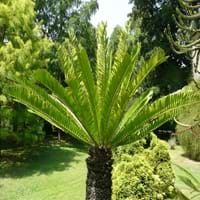Life Span
Perennial
Biennial
Type
Perennial
Palm or Cycad
Origin
Eastern Europe
South Africa
Types
Not Available
Alexandria cycad, Encephalartos caffer, Encephalartos concinnus
Number of Varieties
Not Available
Habitat
Terrestrial
Riverbanks, Rocky areas, Scrubs
USDA Hardiness Zone
4-9
9-12
Sunset Zone
1a, 1b, 2a, 2b, 3a, 3b, 4, 5, 6, 7, 8, 9, 10, 11, 12, 13, 14, 15, 16, 17, 18, 19, 20, 21, 22, 23, 24
H1, H2, 18, 19, 20, 21, 22, 23, 24
Habit
Clump-Forming
Clump-Forming
Flower Color
Yellow, Lavender, Blue Violet
Not Available
Flower Color Modifier
Bicolor
Bicolor
Fruit Color
Not Available
Not Available
Leaf Color in Spring
Green, Sea Green
Green, Dark Green
Leaf Color in Summer
Green, Sea Green
Dark Green
Leaf Color in Fall
Green, Sea Green
Dark Green
Leaf Color in Winter
Light Green
Dark Green
Leaf Shape
Lanceolate
Pinnate
Plant Season
Spring, Summer
Spring, Summer, Fall, Winter
Sunlight
Full Sun, Partial Sun
Full Sun, Partial Sun, Partial shade
Type of Soil
Loam, Sand
Loam, Sand
The pH of Soil
Neutral
Acidic, Neutral, Alkaline
Soil Drainage
Well drained
Well drained
Bloom Time
Spring, Late Spring, Early Summer
Early Summer, Summer
Tolerances
Drought
Drought
Where to Plant?
Ground
Container, Ground, Pot
How to Plant?
By dividing rhizomes, tubers, Seedlings
Seedlings
Plant Maintenance
Medium
Medium
Watering Requirements
Average Water Needs, Do Not over Water
Needs very little water
In Summer
Lots of watering
Lots of watering
In Spring
Moderate
Moderate
In Winter
Average Water
Average Water
Soil pH
Neutral
Acidic, Neutral, Alkaline
Soil Type
Loam, Sand
Loam, Sand
Soil Drainage Capacity
Well drained
Well drained
Sun Exposure
Full Sun, Partial Sun
Full Sun, Partial Sun, Partial shade
Pruning
Remove damaged leaves, Remove dead branches, Remove dead leaves
Remove crossing or rubbing branches, Remove damaged leaves, Remove dead branches, Remove dead leaves, Remove dead or diseased plant parts
Fertilizers
All-Purpose Liquid Fertilizer
All-Purpose Liquid Fertilizer
Pests and Diseases
Red blotch
Red blotch
Plant Tolerance
Drought
Drought
Flowers
Yes
Insignificant
Flower Petal Number
Single
Not Available
Foliage Texture
Coarse
Bold
Foliage Sheen
Matte
Glossy
Attracts
Hummingbirds
Birds, Not Available
Allergy
Skin irritation
Not Available
Aesthetic Uses
Showy Purposes
Showy Purposes
Beauty Benefits
Not Available
Not Available
Environmental Uses
Air purification
Air purification, Shadow Tree, Windbreak
Medicinal Uses
Not Available
Not Available
Part of Plant Used
Not Available
Leaves, Seeds, Stem
Other Uses
Used as Ornamental plant
Used As Food, Used as Ornamental plant, Used for its medicinal properties
Used As Indoor Plant
No
No
Used As Outdoor Plant
Yes
Yes
Garden Design
Alpine, Edging, Mixed Border, Rock Garden, Wall
Feature Plant, Foundation, Mixed Border, Tropical
Botanical Name
IRIS pumila
ENCEPHALARTOS altensteinii
Common Name
Dwarf Iris
Bread Tree, Prickly Cycad
In Hindi
Dwarf Iris
Bread Tree
In German
Zwergiris
Brotbaum
In French
Dwarf Iris
Bread Arbre
In Spanish
Enano Iris
Árbol del pan
In Greek
νάνος Ίρις
ψωμί Δέντρο
In Portuguese
Dwarf Iris
Árvore de pão
In Polish
Dwarf Iris
chleb Drzewo
In Latin
Iris Dwarf
panis ligno
Phylum
Magnoliophyta
Tracheophyta
Class
Liliopsida
Equisetopsida
Family
Iridaceae
Cycadaceae
Clade
Angiosperms, Monocots
Not Available
Tribe
Irideae
Not Available
Subfamily
Iridoideae
Not Available
Number of Species
Not Available
Season and Care of Dwarf Iris and Bread Tree
Season and care of Dwarf Iris and Bread Tree is important to know. While considering everything about Dwarf Iris and Bread Tree Care, growing season is an essential factor. Dwarf Iris season is Spring and Summer and Bread Tree season is Spring and Summer. The type of soil for Dwarf Iris is Loam, Sand and for Bread Tree is Loam, Sand while the PH of soil for Dwarf Iris is Neutral and for Bread Tree is Acidic, Neutral, Alkaline.
Dwarf Iris and Bread Tree Physical Information
Dwarf Iris and Bread Tree physical information is very important for comparison. Dwarf Iris height is 10.20 cm and width 15.20 cm whereas Bread Tree height is 290.00 cm and width 240.00 cm. The color specification of Dwarf Iris and Bread Tree are as follows:
Dwarf Iris flower color: Yellow, Lavender and Blue Violet
Dwarf Iris leaf color: Green and Sea Green
Bread Tree flower color: Not Available
- Bread Tree leaf color: Green and Dark Green
Care of Dwarf Iris and Bread Tree
Care of Dwarf Iris and Bread Tree include pruning, fertilizers, watering etc. Dwarf Iris pruning is done Remove damaged leaves, Remove dead branches and Remove dead leaves and Bread Tree pruning is done Remove crossing or rubbing branches, Remove damaged leaves, Remove dead branches, Remove dead leaves and Remove dead or diseased plant parts. In summer Dwarf Iris needs Lots of watering and in winter, it needs Average Water. Whereas, in summer Bread Tree needs Lots of watering and in winter, it needs Average Water.





